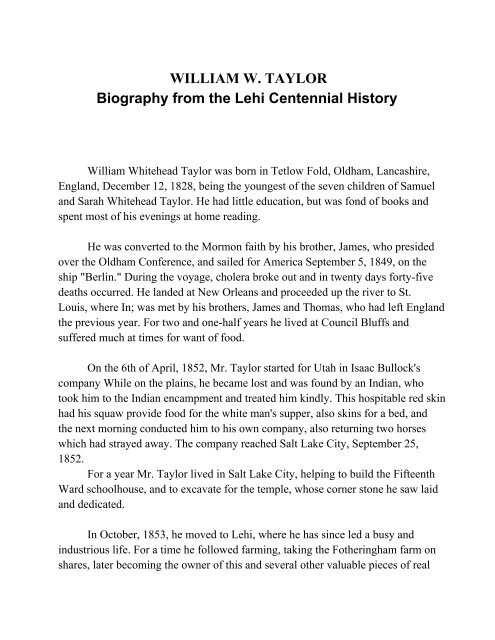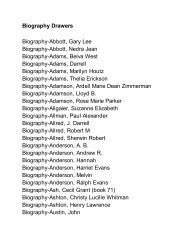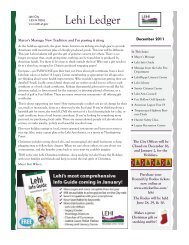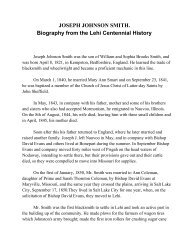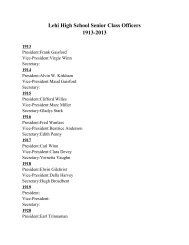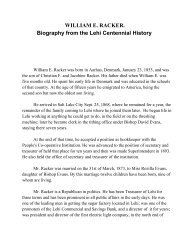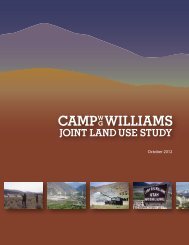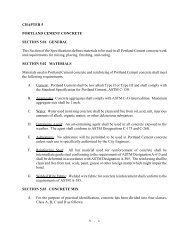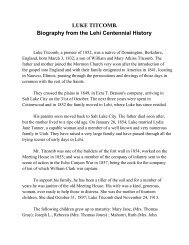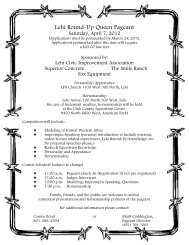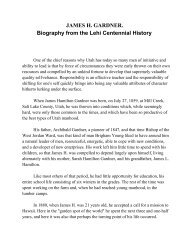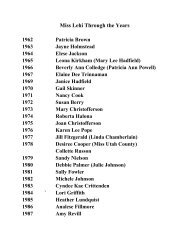WILLIAM W. TAYLOR Biography from the Lehi Centennial ... - Lehi City
WILLIAM W. TAYLOR Biography from the Lehi Centennial ... - Lehi City
WILLIAM W. TAYLOR Biography from the Lehi Centennial ... - Lehi City
Create successful ePaper yourself
Turn your PDF publications into a flip-book with our unique Google optimized e-Paper software.
<strong>WILLIAM</strong> W. <strong>TAYLOR</strong><br />
<strong>Biography</strong> <strong>from</strong> <strong>the</strong> <strong>Lehi</strong> <strong>Centennial</strong> History<br />
William Whitehead Taylor was born in Tetlow Fold, Oldham, Lancashire,<br />
England, December 12, 1828, being <strong>the</strong> youngest of <strong>the</strong> seven children of Samuel<br />
and Sarah Whitehead Taylor. He had little education, but was fond of books and<br />
spent most of his evenings at home reading.<br />
He was converted to <strong>the</strong> Mormon faith by his bro<strong>the</strong>r, James, who presided<br />
over <strong>the</strong> Oldham Conference, and sailed for America September 5, 1849, on <strong>the</strong><br />
ship "Berlin." During <strong>the</strong> voyage, cholera broke out and in twenty days fortyfive<br />
deaths occurred. He landed at New Orleans and proceeded up <strong>the</strong> river to St.<br />
Louis, where In; was met by his bro<strong>the</strong>rs, James and Thomas, who had left England<br />
<strong>the</strong> previous year. For two and onehalf years he lived at Council Bluffs and<br />
suffered much at times for want of food.<br />
On <strong>the</strong> 6th of April, 1852, Mr. Taylor started for Utah in Isaac Bullock's<br />
company While on <strong>the</strong> plains, he became lost and was found by an Indian, who<br />
took him to <strong>the</strong> Indian encampment and treated him kindly. This hospitable red skin<br />
had his squaw provide food for <strong>the</strong> white man's supper, also skins for a bed, and<br />
<strong>the</strong> next morning conducted him to his own company, also returning two horses<br />
which had strayed away. The company reached Salt Lake <strong>City</strong>, September 25,<br />
1852.<br />
For a year Mr. Taylor lived in Salt Lake <strong>City</strong>, helping to build <strong>the</strong> Fifteenth<br />
Ward schoolhouse, and to excavate for <strong>the</strong> temple, whose corner stone he saw laid<br />
and dedicated.<br />
In October, 1853, he moved to <strong>Lehi</strong>, where he has since led a busy and<br />
industrious life. For a time he followed farming, taking <strong>the</strong> Fo<strong>the</strong>ringham farm on<br />
shares, later becoming <strong>the</strong> owner of this and several o<strong>the</strong>r valuable pieces of real
estate. In connection with his bro<strong>the</strong>r Thomas he founded <strong>the</strong> mercantile firm of T.<br />
and W. Taylor, which conducted <strong>the</strong> first store in <strong>Lehi</strong>. During <strong>the</strong> latter years of his<br />
life, he engaged in <strong>the</strong> dairying business.<br />
In 1853, he married Nannie Standring, who was born in Layton, Lancashire,<br />
England, July 24, 1826, being <strong>the</strong> daughter of James and Mary Halliwell Standring;<br />
and four years later he married Charlotte E. Leggett, a daughter of Conrad and<br />
Louisa Leggett, who was born October 9, 1837, in Ohio, and who was <strong>the</strong> mo<strong>the</strong>r<br />
of five children.<br />
In May, 1855, he was a member of <strong>the</strong> White Mountain expedition and <strong>from</strong><br />
<strong>the</strong> spring of 1869 to <strong>the</strong> fall of 1870, was absent upon a mission to England, where<br />
he labored as traveling elder in <strong>the</strong> Manchester conference, and afterward presided<br />
successively over that and <strong>the</strong> Leeds conference. He returned home on account of<br />
ill health.<br />
He was secretary of <strong>the</strong> <strong>Lehi</strong> Dramatic Association, <strong>the</strong> pioneer dramatic<br />
organization, and one of <strong>the</strong> leading players. He was at one time a member of <strong>the</strong><br />
<strong>City</strong> Council and also connected with <strong>the</strong> local military organization. Although he<br />
preferred a quiet life and was never much of a public man, yet he was one of <strong>the</strong><br />
staunch and sturdy men of <strong>the</strong> community, ever ready to help in every worthy<br />
cause.<br />
Charlotte E. L. Taylor died February 20, 1909. Nannie S. Taylor died June<br />
15, 1913. Wm. W. Taylor died November 17, 1907.


